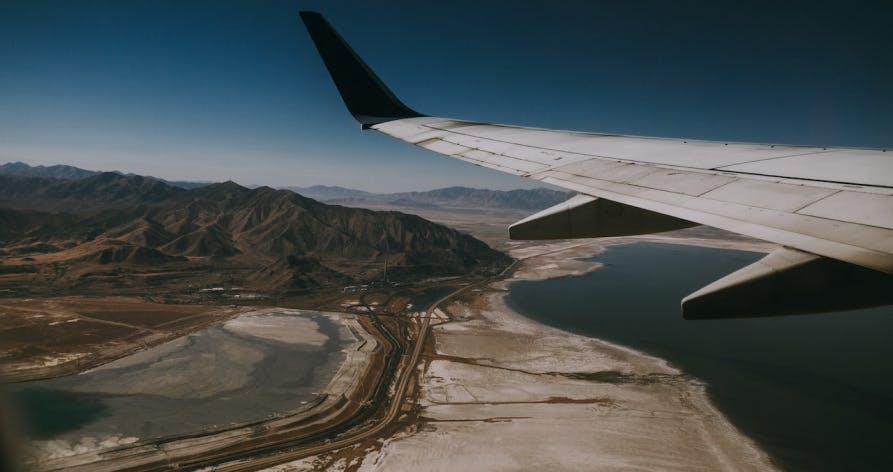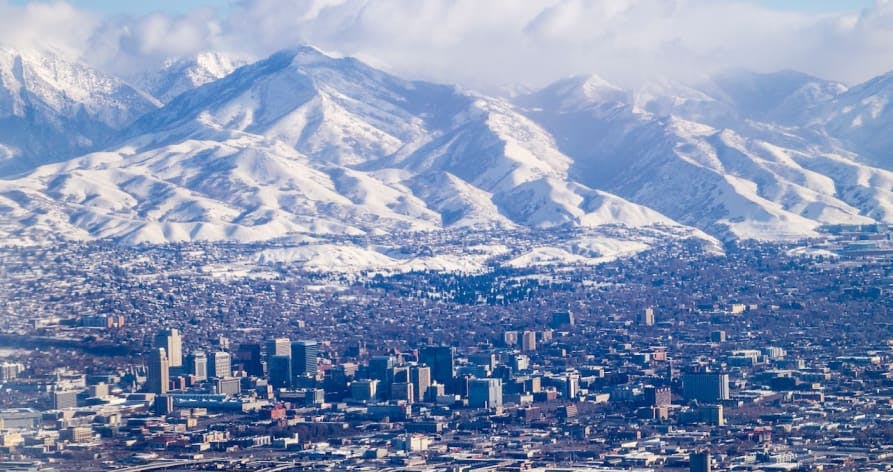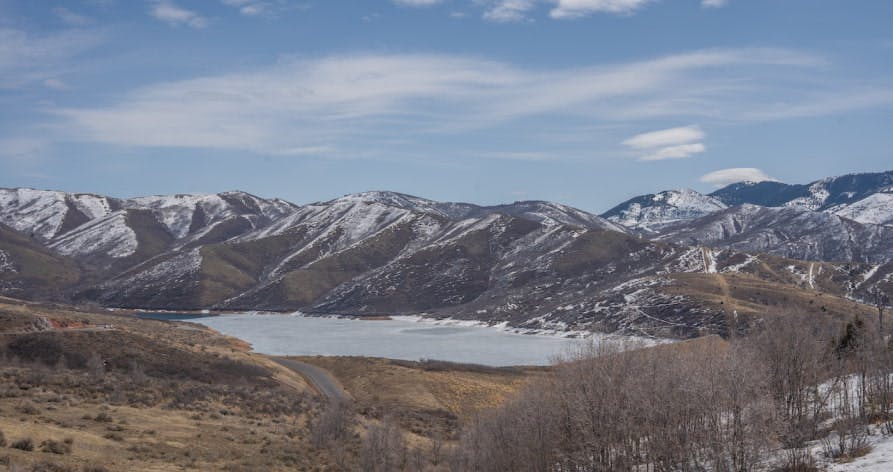ESG / CSR
Industries
What is the Problem With the Great Salt Lake Drying up?



Climate change isn't only causing wildfires and massive heat waves, but it's drying up vital bodies of water such as the Great Salt Lake bordering the Salt Lake Valley.
👉 Why is it problematic that bodies of water like the Great Salt Lake are drying up? How can societies compensate for the water sources that are dissipating due to global warming?
What is the Great Salt Lake and why is it important?
Utah's Great Salt Lake
When you hear of the Great Salt Lake, it may be easy to immediately think of the beautiful city in Utah near Salt Lake Valley – but did you know that the Utah's Great Salt Lake is more than just a body of water in a well-known U.S. city?
👉 The Great Salt Lake, located in northern Utah and remnant of Lake Bonneville, makes up a massive 1,700 square miles, and its watershed spans over 21,000 square miles – making it the largest salt water lake in the Western Hemisphere. No water flows out of the Great Salt Lake, making it a closed water basin and the lowest point in its surrounding landscape.
The Western Hemisphere's largest saltwater lake, the Great Salt Lake, receives fresh water collected from precipitation, and the water that feeds into the Great Salt Lake has dissolved minerals that eventually evaporate and leave the various minerals, toxic dust, and salts behind – therefore, part of the reasoning it is called, the Great “Salt” Lake. In fact, Salt Lake City was almost referred to as, "Great Salt Lake City" – until ultimately dropping the "great" from the name and leaving it for the body of salty water.

Why is the Great Salt Lake important?
The Great Salt Lake also serves as a vital part of the regional ecosystem for migratory birds. In fact, more than seven million birds pass through the Great Salt Lake annually to replenish and nest new eggs.
The Great Salt Lake is also home to bacteria such as algae, zooplankton, brine shrimp, and brine flies that help to suffice the food chain. Much of the wildlife crisis surrounding the Great Salt Lake is prevalent in surrounding areas such as Antelope Island and Antelope Island State Park, and is shown in the limited fishing available in the area, such as near fresh water inlets.
In short, the Great Salt Lake and the surrounding mountains near the south shore in Utah state parks aren't only a beautiful place for tourists and Utah residents alike to go, boating, swimming, hiking, or even witness the "lake effect" for picturesque scenery and photos – but it plays a crucial role in not only supplying water for people who reside in the vicinity of the lake, but for the wildlife that depends on the resources the Great Salt Lake provides.
Why is the Great Salt Lake drying up?
The deadly combination of climate change and urbanization are contributing to the Great Salt Lake drying up, as both create toxic dusts that poison the air surrounding Salt Lake City. High temperatures provoke water to evaporate at an unprecedented rate, and that in combination with the excessive carbon dioxide or greenhouse gas emissions polluting the air due to the industrialization required for urbanization in Salt Lake City – the Great Salt Lake has been negatively impacted.
In other words, the Great Salt Lake can't sustain itself with incessantly rising temperatures or excessive emissions in the air that alter the salt content in the lake.
The Great Salt Lake has already shrunk by two thirds, with the lake reaching its lowest point last summer. Unfortunately, the lake is only expected to shrink even more in the coming year.
The Great Salt Lake used to have a salt content that varied between nine and twelve percent, but as the amount of water in the lake has drastically decreased – the salt content has spiked to a whopping seventeen percent. This makes the lake difficult for the algae in the water to survive, which means the brine shrimp will no longer be able to consume the algae, and ultimately impact the rest of the food chain and surrounding ecosystem.

How will the Great Salt Lake drying up impact biodiversity?
If the Great Salt Lake continues to dry up, it means that the lake's flies and brine shrimp won't be able to survive due to the potentially inedible algae. It will also impact the millions of migratory birds that depend on the lake as a resource in the midst of their migration. Vital minerals and magnesium that the Great Salt Lake provides could come to a screeching halt.
👉 In terms of tourism, the Great Salt Lake during up will impact the ski conditions at the resorts, which serve as a crucial source of income for Salt Lake City.
However, the most deleterious effect of the Great Salt Lake drying up is that the air surrounding Salt Lake City could sporadically become poisonous.
Since the bed of the Great Salt Lake holds high levels of dangerous particles like arsenic, antimony, copper, zirconium, and various heavy metals. If a wind storm were to occur, it could transmit those toxic particles into the lungs of residents.
Being coined in the media as a potential, “nuclear bomb” – the Great Salt Lake drying up is a serious threat to human health. If the Great Salt Lake dries up, it could make the entire city inhabitable – and force residents to flee and contribute to urbanization even more, which will ironically produce even more greenhouse gas emissions and perpetuate environmental crises like the one on hand.
The Great Salt Lake drying up could create a toxic environment for residents, and practically destroy the ecosystem in the Salt Lake region.
Will the Great Salt Lake drying up impact Salt Lake City's water supply?
The Great Salt Lake drying up could impact Salt Lake City's supply of water, but not if other measures are taken to mitigate the current amount of water being sourced from the Great Salt Lake. In other words, as the Great Salt Lake is drying up – it's imperative that the city strives to preserve the water that is left there to prevent the lake from drying out and becoming obsolete.
Theoretically, the Great Salt Lake could be replenished easily if more water could reach the lake from melting snow packs and if Salt Lake Country reduced the amount of water allotted to be consumed by residences and businesses alike.
However, all hope isn't lost yet for the Great Salt Lake or people who live in the Salt Lake City area. Potential solutions include sourcing more water from alternative rivers or streams, to recycle wastewater, or extract water from wells. These methods would help to reduce the amount of water being removed from the Great Salt Lake, and they need to be taken fast – otherwise, the city could run out of water entirely as soon as 2040.
Salt Lake City has already been trying to implement these water reduction strategies for many months now, having required late last year that no permits should be issued to businesses that demand large amounts of water to operate. However, government leaders are missing perhaps the most powerful incentive to reduce water usage – money.
If legislation were passed in the Salt Lake City metropolitan area to increase the price of water, people and businesses would have no choice but to find ulterior methods to run their businesses or day to day lives with less. It is clear that by this point, concrete laws that encourage fines for the overuse of water may be the only solution to preserve what is left of the Great Salt Lake.
How else will the Great Salt Lake drying up impact climate change?
The Great Salt Lake is bound to impact more than just the amount of water available, but also the health of humans and the biodiversity that once depended on the lake.
If the Great Salt Lake is to dry up completely, it will become reminiscent of the Owens River – a body of water that once served as a main source of water for many in the Los Angeles area that completely dried up. Now, not only is a vital source of water gone, but the aftermath of the dried-up bed where the water used to it has continuously proven itself problematic.
In fact, the Owens River served as one of the greatest sources of dust pollution in the United States during the 1900s. Given the Great Salt Lake is nineteen times the size of the once-existing Owens River – the impact a dried-up Great Salt Lake could have on pollution is menacing.
Is there anything that can be done to prevent the Great Salt lake from drying up more than it already has?
Until local governments in the Salt Lake City region establish firm fines for overusing water, preventing the Great Salt Lake from drying up will be contingent on the individuals who reside in the surrounding areas that depend on the lake for water – and that has proven difficult.
Conserving water may seem challenging, but the reality is that residents of Salt Lake City should assimilate to the concept sooner than later as it seems that preserving water may become a part of life in this part of the country. People who move to bigger cities like New York City often have to settle for a smaller apartment. Those who choose Salt Lake City may have to settle for conserving water on a daily basis in areas of their life where they normally wouldn't.
So, how can you start conserving water before it becomes compulsory in Salt Lake City?
Turns out, conserving water doesn't just mean aiming to take shorter showers or turn the kitchen sink off when you aren't using the running water. First off, it's imperative to check for any leaks in your house – as you could be going through superfluous water without even realizing it. These water leaks could come from the toilet, faucets, or pipes.
If you find it difficult to cut down your shower time, you could opt to install a water-saving shower head or one that restricts the flow of water. Whilst shaving or shampooing, strive to turn the water off when it's not necessary.
Energy efficiency appliances don't only help reduce the amount of electricity used, but it could help reduce the amount of water used. The next time you're in the market for a new washing machine, look for one that aims to make do with less water. If it isn't possible to purchase a new machine, try your best to only run the washing machine when you have a full load of laundry to optimize the water that will be used.
These are all great habits to implement into your daily routine to conserve water, but the truth is that they won't be enough to save what's left of the Great Salt Lake. Governments need to create fiscal incentives now to prevent public entities and businesses from depleting the lake more than it already has been, or else humans and wildlife will inevitably suffer the aftermath of another bare-boned lake.
What about Greenly?
If reading this article about the Great Salt Lake drying up has made you interested in reducing your carbon emission to further fight against climate change – Greenly can help you!
Greenly can help you make an environmental change for the better, starting with a carbon footprint assessment to know how much carbon emissions your company produces.
Click here to learn more about Greenly and how we can help you reduce your carbon footprint.
Don't wait any longer, take the first step towards reducing your carbon footprint by requesting a free and non-binding demo with one of our experts today and finding the solution that best fits your business needs.




